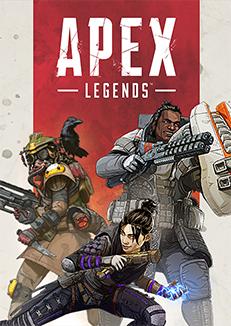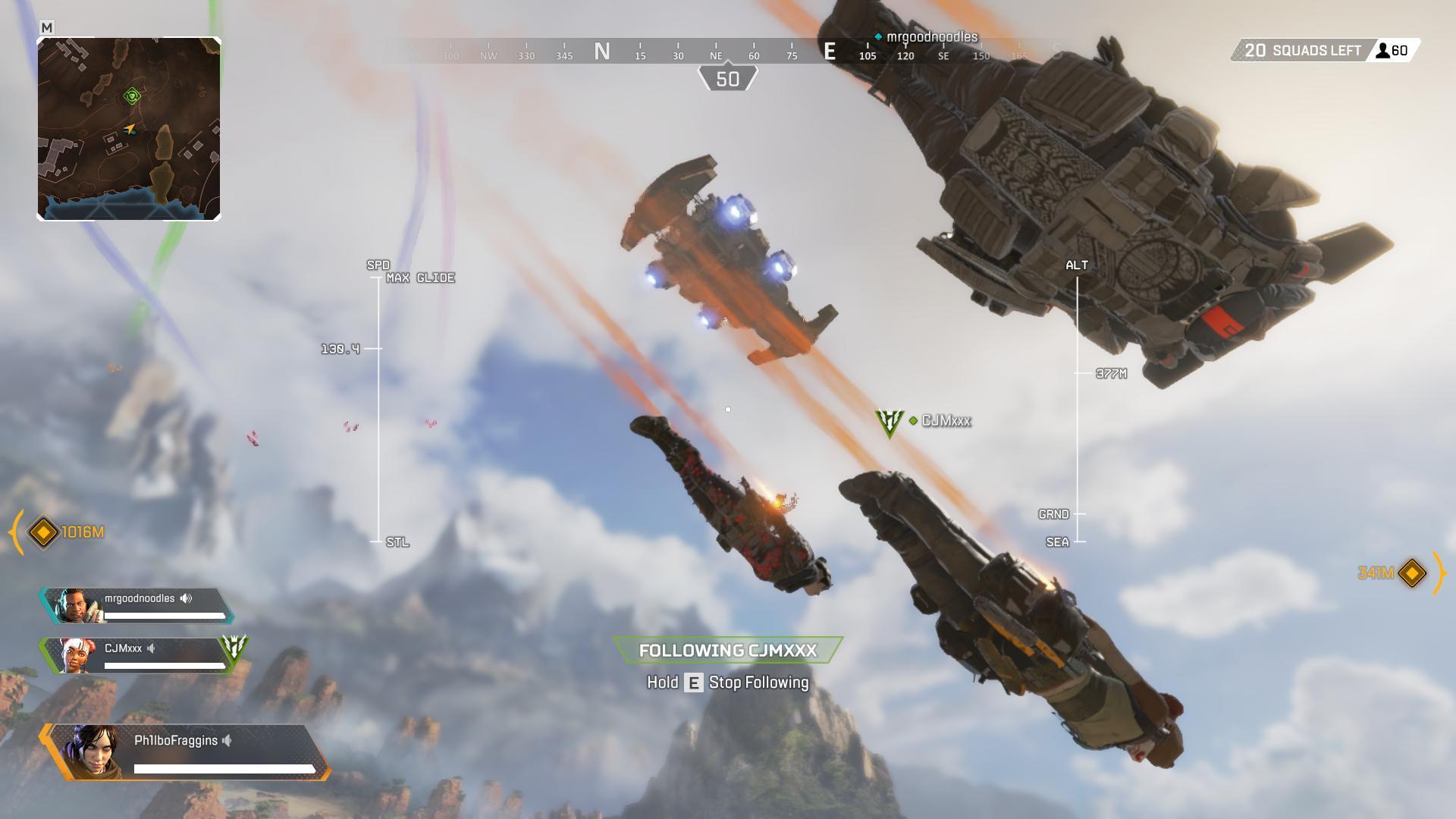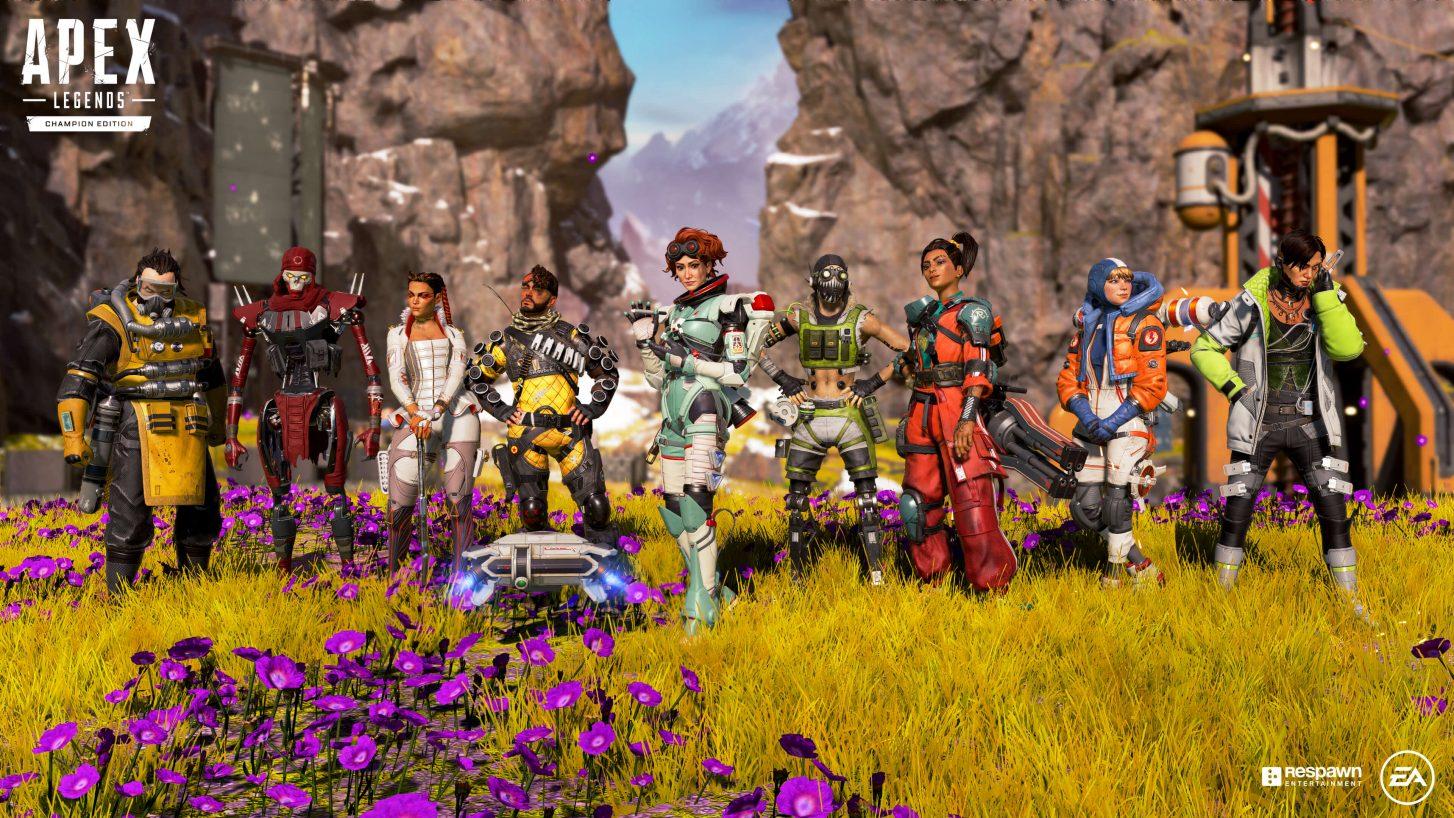Apex Legends is a Battle Royale game, by Respawn Entertainment, available on console and PC. The target audience is fans of multiplayer FPS’s in general. It mixes characters with specific ability sets, as per Overwatch or Valorant, with dynamic movement and a slightly longer time to kill, making it closer to something like Call of Duty or Halo than a slower-paced tactical FPS like CS:GO. As with any Battle Royale, the ultimate goal is to be the last team standing. To get there, each team goes through a loop of scavenging for weapons and equipment to get stronger, fighting teams for position and loot, and finding a better position as the ring closes, and so on until there’s a winner. The verbset is largely the same as other shooters in the genre – move, shoot, loot – with the addition of character-specific abilities and some unique features on the map, like balloons that let you traverse the map quickly from set locations or neutral mobs to kill for items.
Single Player
There’s no single player in Apex Legends, so balancing that experience isn’t an issue.

Asymmetry & Starting Positions
Technically, the starting position of each player, prior to dropping into a level, is largely symmetrical. Everyone is on the same dropship, and can choose from the same roster of characters.
However, the choices they make in-game, and in the lobby beforehand, quickly introduce asymmetry – often modulated by strategy, and the choices that other players make. There are different points of interest on the map – places with loot and architecture to hold and fight in. Although there are enough for each of the 20 teams to have a decent start, they aren’t created equal. They’re divided into zones based on the quality of loot, and depending on the specific path of the ship some result in much harder rotations into the later game circles. This means that some will be more desirable than others, which should mean that in turn they’re more heavily contested by teams. So, if there’s one strictly best point of interest, then in theory it will also be the hardest to successfully take since more players will go there. To some extent, this functions as a sort of natural balancing.
However, there’s other considerations. If you make one desirable point of interest, then you could have a lot of the lobby die off early into the match. Then you’ll have a much lower population later on, and characters that thrive in close-range situations, where there’s very little playable space left, will suffer. So, the different types of starting positions you encourage, not just the ones any specific player chooses, also has a substantial impact on balance. Striking this balance between encouraging early game combat, while also ensuring that players still can fight later on, is a difficult challenge still being addressed. For example, the very first map had a location, ‘Skulltown’, that ended up being an absolute bloodbath early game since it was a large space with a lot of starting rooms. In initial playtests, this didn’t show up, since everyone wanted to survive long enough to get to the next round of internal playtesting – you don’t want to sit the rest of it out. However, this isn’t a factor in actual games – you just queue up again. So, since playtesting isn’t actually equivalent to a live game it can be hard to detect these situations beforehand.
Currently, there’s a system for Ranked gameplay that rewards more points for surviving longer. Although this isn’t an actual element within the match itself – it doesn’t give you any power – it has meant that player strategies have shifted towards survival, especially as you rise through the ranks, and has meant players tend towards more defensive legends (as do I!). So, it isn’t even just actual gameplay elements that dictate how balance determines one’s experience – it’s also systems layered on top.
Balance Between Objects
Finally, of course, there’s the balance between different ‘objects’ – the weapons, or characters. Although you can reduce this down to damage per minute, mitigated by ease of access, there’s also some weapons that break this calculation. For example, until recently a sniper rifle called the Kraber could kill anyone, with any armor, in one headshot. It was rare, but it meant that the time to kill was practically instant, and the gear choices everyone else made in the late game were largely irrelevant since they could be killed before they could have a chance to react. So, although it seemed like it was simply somewhere along a cost-benefit spectrum, since it was so far along the power curve it effectively broke it in a way no other weapon did.
 Intransitive Balance
Intransitive Balance
Many of the characters, in theory, function in an intransitive way in relation to each other. For example, one legend, Crypto, can destroy shields every few minutes with his ‘ultimate’ ability. Against many legends, this just means that they lose some of their shield health. However, against a handful who create shields as their abilities – specifically, Gibraltar, a defensive legend who can create an invulnerable bubble – this ability becomes a much harder counter, removing one of their main defensive options. In practice, this does mean that Crypto does get specifically picked as a counter – the paper to Gibraltar’s rock. It’s difficult or even impossible to reduce abilities like this – or Crypto’s ability to send out a scouting drone, or so on – to a single number. However, it also isn’t as simple as looking at who counters whom to decide balance. Each team is composed of 3 legends, and different compositions have different interactions with one another. Getting into the competitive metagame of Apex Legends would make this very long post even longer, but suffice to say that different compositions, with only one character changed, play very differently. Adding Valkyrie, a character with a long range reposition, can make an otherwise immobile composition that tries to just turtle up in a building much more viable, since they can get to those prime positions much more easily, for example.
Fruity Balance
Ultimately, many of these abilities are ‘fruity’ – they’re apples to apples comparisons. Although you can compare a jump pad to a portal or a zip line, it doesn’t make as much sense to compare it to a build-your-own wall, another characters ability.
Transitive Balance
What ultimately brings these disparate abilities together, and grounds them, is the fundamental gunplay, and the transitive values that can basically be assigned to loot – the weapons you use to fight one another. These can be balanced in terms of damage output, effective range, and so on, and the ultimately different characters kits can be summed up by statistics like encounter win rates versus others, to try and capture what’s otherwise a fairly different set of powers. This gives a way to get a good sense of how the various balance levers – abilities, map design, weapons, and so on – ultimately manifest in the game itself.
I think this speaks to something that wasn’t necessarily addressed in the article we read. Although there’s a lot of different systems to balance, a spreadsheet doesn’t express their relative importance – that’s a choice designers have to make for themselves. Part of what appeals to me about games like Apex or Valorant is that, at the end of the day, all the abilities in the world won’t save you when you can die in 1 or 2 seconds during gunplay. This helps allow for what might otherwise seem like game-breaking abilities – i.e., one character in Apex can fly – since ultimately the combat system is a great equalizer. I think this is a huge boon, since it means players can get a really exciting set of toys to play with that might feel imbalanced – in a good way – to the player, or sound like they’d be broken, but ultimately are totally reasonable.


